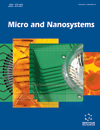- Home
- A-Z Publications
- Micro and Nanosystems
- Previous Issues
- Volume 12, Issue 2, 2020
Micro and Nanosystems - Volume 12, Issue 2, 2020
Volume 12, Issue 2, 2020
-
-
Synthesis and Spectral Characterizations of Nano-Sized Lithium Niobate (LiNbO3) Ceramic
More LessBackground: Lithium Niobate (LiNbO3) is a ferroelectric material suitable for a variety of applications. Its versatilityis made possible by the excellent electro-optic, nonlinear, and piezoelectric properties of the intrinsic material. Objective: Study of structural, microstructural and electrical propertiesare to understand the structure and topography of the composites. Methods: The sample of LiNbO3 was prepared by solid sta Read More
-
-
-
Structural and Thermal Study of Mg2TiO4 Nanoparticles Synthesized by Mechanical Alloying Method
More LessAuthors: Ranjan K. Bhuyan, D. Pamu, Basanta K. Sahoo and Ashish K. SarangiBackground: Mg2TiO4 – based ceramics have proven their potentiality in the field of wireless communication systems. In the past, Mg2TiO4 ceramics was considered a quite optical response material in thin film form. Moreover, there is very few studies have been done whatever the proposed work in the present study. Objective: To prepare Mg2TiO4 nano-powders with the help of High Energy Ball Mill (HEBM) and inte Read More
-
-
-
Preparation and Characterization of Highly Fluorescent TGA-CdTe Quantum Dot-Hyamine 1622 Additive Composite
More LessAuthors: Md. Kudrat-E-Zahan, Salih Z. Yildiz and Senem Colak YaziciObjective: The aim of the present study was to prepare highly luminescent additive composite polymer with hyamine 1622 and Thioglycolic Acid (TGA) coated CdTe Quantum Dots (QDs). Methods: The additive nano-composite was synthesized by the colloid synthesis method for the first time. The properties like particle size, fluorescence efficiency, fluorescence imaging, self-assembling, quantum dots, encapsulation, etc. were Read More
-
-
-
Effect of Particle Size Distribution and Selective Alcohol Additives for Preparation of High Concentration Coal-Water Slurry
More LessBackground: The alternative of oil is highly essential in the present context due to the acute shortage of oil as well as increasing demand for it from different public and private sectors. Since 1980, attention has been focused on coal-water slurry as an alternative fuel for the power generation industry and a suitable substitute for oil in several industrial applications. One of the exciting areas in Coal Water Slurry (CWS) is coal–wa Read More
-
-
-
In Silico Design of a Single Protein Molecular Photoreaction Center
More LessAuthors: Nibedita Mishra, Pranab K. Mohapatra and Mukesh K. RavalBackground: Research on harvesting solar energy through an artificial photosynthetic device is gaining momentum in the present era. The device is a promising solution to the energy crisis by overcoming the crunch in fossil fuel and low efficiency of heat engine. Reports are available on design of isolated parts of the photosynthetic device, for example, only sensitizer or only redox unit containing metallo-peptides. Objective: An att Read More
-
-
-
Nanoscale Analysis on Spark Plasma Sintered Fly-Ash Bricks and their Comparative Study with SiN-Zr Refractory Bricks
More LessAuthors: D.K. Sahoo, M.S.V.R. Kishor, D.P. Sahoo, S. Sarkar and A. BeheraBackground: Industries such as thermal power plants use coal as a source of energy and release the combustion products into the environment. The generation of these wastes is inevitable and thus needed to be reused. In India, coals with high ash content usually between 25 to 45% are used. The refractory bricks that were used earlier in steel industries were mainly based on silica, magnesia, chrome, graphite. In moder Read More
-
-
-
Nitrogen, Sulfur Co-Doped Reduced Graphene Oxide: Synthesis and Characterization
More LessAuthors: Md. Abdul Mannan, Yudai Hirano, Armando T. Quitain, Michio Koinuma and Tetsuya KidaObjective and Method: In this present research, a simple hydrothermal implantation technique for synthesizing N,S co-doped reduced graphene oxide (NS-r-GO) has been presented in which thiourea was used as a single-source precursor of N and S atoms. Results: Maximum N and S atoms, with an atomic percentage of 3.50 and 7.50 (at.%), were achieved in the GO matrix at the reaction temperature of 250°C. Introduction Read More
-
-
-
Preparation of TiO2 and SiO2 Nanoparticles and their Effect on Epoxy Resin Nanocomposites
More LessAuthors: Gagi T. Rahman, Moumita Tasnim Meem, Md. Abdul Gafur, Abu Mahmud and Md. Asadul HoqueBackground: Polymer matrix-based composites are the workhorse of the composite industries. Besides, the idea of modifying the polymer matrix by various inorganic fillers has greatly drawn the attention of materials engineers due to their diversified applications and advanced properties. Objective: The objective of this work was to prepare and characterize Titania (TiO2) and Silica (SiO2) nanoparticles and develop 1wt%, 3 Read More
-
Most Read This Month
Article
content/journals/mns
Journal
10
5
false
en


